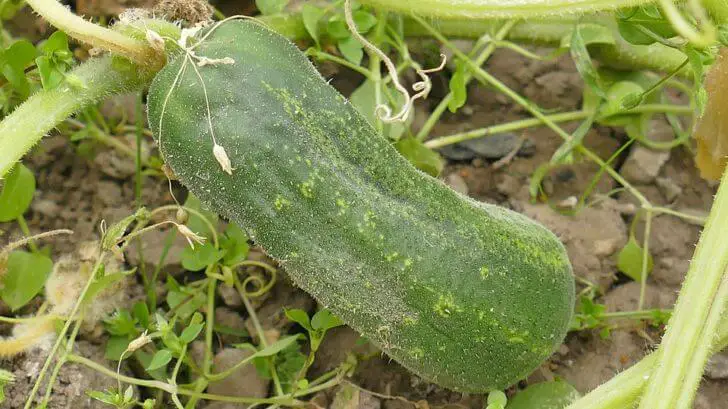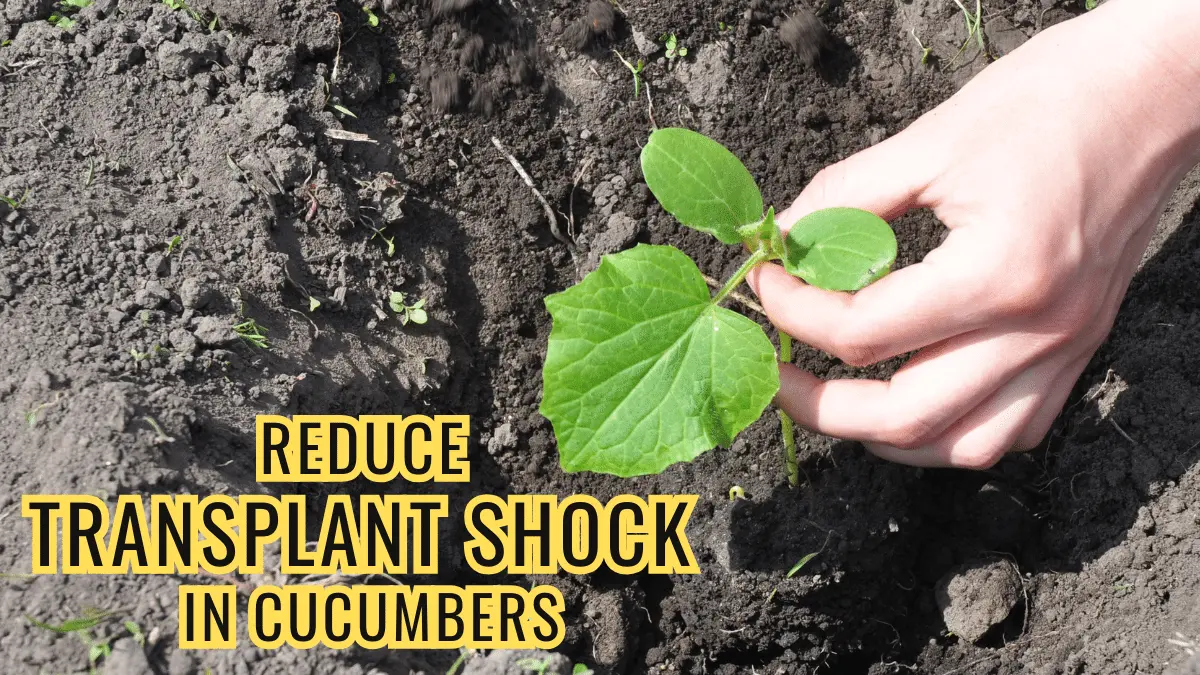We use affiliate links to run our site. When you buy through links on our site, we may earn an affiliate commission, without any added cost to you. Learn more
Transplanting cucumber seedlings from pots or trays into the garden can be a tricky process. Cucumbers are especially sensitive to disturbances during this transition. Even slight root damage or changes in growing conditions can stress young cucumber plants, leading to transplant shock.
Transplant shock refers to the stunted growth and reduced yields that often occur when cucumbers and other vegetables are moved from one location to another. The disturbed root system struggles to absorb water and nutrients, while leaves are exposed to more sun and wind.
Fortunately, there are several effective techniques gardeners can use to reduce transplant shock in cucumbers.
Growing Cucumbers: How to Plant, Water and Care A Cucumber Plant
Table of Contents
Quick Snapshot:
| Measure | Description |
| Avoid Root Disturbance | Be careful not to disturb cucumber roots during transplant. |
| Use Root Stimulator | Apply a root stimulator to encourage root growth and recovery. |
| Maintain Consistent Soil Level | Keep the soil level the same as before transplanting to reduce stress. |
| Provide Partial Shade | Shield cucumber plants from excessive sunlight for the first week or two. |
| Keep Soil Moist | Ensure the soil remains consistently moist, especially before transplanting. |
| Protect from Wind | Use barriers or structures to protect plants from wind-induced stress. |
| Transplant Immediately | Transplant cucumber plants promptly after removing them from pots or soil. |
| Apply Mulch | Mulch around the base of the plant to retain moisture and attract beneficial insects. |
Understanding Cucumber Types
Cucumbers come in two main varieties – vine and bush. Vine cucumbers spread out long runners along the ground. They require trellising or staking for support. Bush cucumbers grow in a compact mound shape without runners. Both types need protection from transplant shock to thrive.
Cucumbers are a warm-season crop, making them a popular choice for home gardens. Given the right care, cucumbers produce abundantly from midsummer into fall. Avoiding transplant shock helps ensure a hearty harvest.
Causes of Transplant Shock

Young cucumber plants are tender and vulnerable to sudden changes. When relocating cucumbers, it’s important to minimize stressors that contribute to transplant shock:
Root Damage
Cucumber roots are incredibly sensitive to disturbances. Even small tears or broken roots during transplanting can stress the plant. Carefully handling seedlings to keep roots intact prevents shock.
Soil Depth Changes
If planted too deeply or shallowly, cucumber roots struggle to access oxygen and water. Maintaining consistent soil depth avoids this issue.
Exposure to Sun and Wind
Cucumber leaves accustomed to greenhouse or indoor conditions are sensitive to harsh sun and wind. Exposure during transplanting adds stress. Providing shade helps leaves adjust.
Cucumber Leaves Turning White? Here are 7 Key Reasons and Their Cures
How to Reduce Transplant Shock
Here are 8 techniques experts recommend for preventing transplant shock in cucumbers:

1. Avoid Disturbing Roots
- Use a garden fork to gently loosen the soil and dig at least 6 inches away from the stem when removing seedlings from pots or trays. This gives you room to maneuver without damaging delicate root strands.
- Slowly lift the seedling using the leaves as handles, not the stem. Support the soil and root ball underneath.
- Carefully untangle any tangled roots by hand or using a blunt object like a chopstick. Spread roots outward in the shape of an open hand.
- Before placing the seedlings in the garden bed, dig a hole at the same depth as the root ball. Make sure the tiny root hairs at the tip are covered by soil. Pat soil firmly but don’t pack tightly.
2. Use a Root Stimulator
- Look for organic biostimulants containing seaweed extract or mycorrhizae to promote fast root regrowth. Apply as a soil drench or root dip.
- Sprinkle mycorrhizal inoculant in the planting hole and over the roots to boost nutrient uptake. The beneficial fungi form symbiotic relationships with plants.
- Stimulators with hormone-like properties can help cucumbers overcome stress. Search for products designed specifically for transplant use.
3. Maintain Consistent Soil Depth
- Check the depth of the potting mix in the original container. Recreate this in the garden bed by digging a hole to match.
- To avoid burying the stem, ensure the first set of leaves sits just above the soil surface. Cucumber stems tend to rot if buried.
- In windy areas, plant a bit deeper for added stability. Just be sure at least 2 sets of leaves remain above ground.
4. Provide Partial Shade
- Shield plants from the direct sun about halfway, allowing some dappled sunlight to still reach leaves.
- Make removable shade covers using wooden planks, umbrellas, cardboard boxes, or shade cloth on posts. Remove gradually over 2 weeks.
- Alternatively, choose planting sites that receive morning sun but afternoon shade, like the east side of taller plants or structures.
5. Keep Soil Moist
- Water transplants thoroughly 1-2 hours before removing them from pots. This hydrates roots and makes soil easier to handle.
- After transplanting, apply water slowly at the soil level to saturate the root zone without disturbing the surface. Avoid overhead watering.
- Add mulch to retain moisture while plants establish. Continue consistent watering 2-3 times per week if rain is lacking.
6. Protect from Wind
- Anchor shade fabric, plastic sheeting, or burlap vertically around plants using stakes or hoops. This creates a wind barrier.
- Partially block prevailing winds by situating transplants behind other planted beds, trellises, yard structures, or other obstacles.
- Shield small plants with cloches, plastic bottles with bottoms removed, or other improvised shelters. Ventilate on warm days.
Do Cucumber Plants Need Support?
7. Transplant Immediately
- Time transplanting for a cool, cloudy period. Midday heat and sun add stress.
- Have new holes prepped and ready to receive plants. Gently place seedlings and fill holes quickly.
- If transplanting must be delayed, set plants in a shady spot and keep roots moist by covering them with wet burlap.
8. Apply Mulch
- Use 2-3 inches of loose, lightweight mulch that allows air and water movement, like straw, shredded leaves, or bark. Avoid packing tightly around the stem.
- Leave a small circle uncovered around each seedling to prevent disease. Reapply mulch as it decomposes.
- Organic mulches improve soil health as they break down. Inorganic options like stones retain less moisture but don’t require replacement.
Conclusion
Cucumber transplant shock can stunt plants and limit yields. Following these tips minimizes disturbances that trigger shock. Pay close attention to gently handling roots and maintaining soil moisture.
With extra care taken during transplanting, cucumbers establish quickly and flourish in the garden. Homegrown cucumbers make a refreshing, nutritious summer treat when transplant shock is prevented.
Amazon and the Amazon logo are trademarks of Amazon.com, Inc, or its affiliates.

Hi there! My name is Prasenjit and I’m an avid gardener and someone who has grown a passion for growing plants. From my hands-on experience, I have learned what works and what doesn’t. Here I share everything I have learned.
